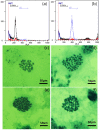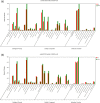Character changes and Transcriptomic analysis of a cassava sexual Tetraploid
- PMID: 33874893
- PMCID: PMC8056498
- DOI: 10.1186/s12870-021-02963-1
Character changes and Transcriptomic analysis of a cassava sexual Tetraploid
Abstract
Background: Cassava (Manihot esculenta Crantz) is an important food crop known for its high starch content. Polyploid breeding is effective in its genetic improvement, and use of 2n gametes in sexual polyploid breeding is one of the potential methods for cassava breeding and improvement. In our study, the cassava sexual tetraploid (ST), which carries numerous valuable traits, was successfully generated by hybridizing 2n female gametes SC5 (♀) and 2n male gametes SC10 (♂). However, the molecular mechanisms remain unclear. To understand these underlying molecular mechanisms behind the phenotypic alterations and heterosis in ST plants, we investigated the differences in gene expression between polyploids and diploids by determining the transcriptomes of the ST plant and its parents during the tuber root enlargement period. We also compared the characters and transcriptomes of the ST plant with its parents.
Results: The ST plant was superior in plant height, stem diameter, leaf area, petiole length, plant weight, and root weight than the parent plants, except the leaf number, which was lower. The number of starch granules was higher in the roots of ST plants than those in the parent plants after five months (tuber root enlargement period), which could be due to a higher leaf net photosynthetic rate leading to early filling of starch granules. Based on transcriptome analysis, we identified 2934 and 3171 differentially expressed genes (DEGs) in the ST plant as compared to its female and male parents, respectively. Pathway enrichment analyses revealed that flavonoid biosynthesis and glycolysis/gluconeogenesis were significantly enriched in the ST plants, which might contribute to the colors of petiole (purple-red), root epidermis (dark brown), and tuber starch accumulation, respectively.
Conclusions: After sexual polyploidization, the phenotype of ST has changed significantly in comparison to their diploid parents, mainly manifest as enlarged biomass, yield, early starch filling, deep colored petiole and root epidermis. The tetraploid plants were also mature early due to early starch grain filling. Owing to enriched flavonoid biosynthesis and glycolysis/gluconeogenesis, they are possibly resistant to adversity stresses and provide better yield, respectively.
Keywords: Characters; Differentially expressed genes; Manihot esculenta Crantz; Sexual tetraploids; Transcriptome.
Conflict of interest statement
The authors declare that they have no competing interests.
Figures









Similar articles
-
Changes in sucrose metabolism patterns affect the early maturation of Cassava sexual tetraploid roots.BMC Plant Biol. 2022 Dec 10;22(1):574. doi: 10.1186/s12870-022-03969-z. BMC Plant Biol. 2022. PMID: 36496357 Free PMC article.
-
Comparison of leaf transcriptomes of cassava "Xinxuan 048" diploid and autotetraploid plants.Genes Genomics. 2018 Sep;40(9):927-935. doi: 10.1007/s13258-018-0692-2. Epub 2018 May 15. Genes Genomics. 2018. PMID: 30155710
-
The search for yield predictors for mature field-grown plants from juvenile pot-grown cassava (Manihot esculenta Crantz).PLoS One. 2020 May 6;15(5):e0232595. doi: 10.1371/journal.pone.0232595. eCollection 2020. PLoS One. 2020. PMID: 32374747 Free PMC article.
-
Cassava biology and physiology.Plant Mol Biol. 2004 Nov;56(4):481-501. doi: 10.1007/s11103-005-2270-7. Plant Mol Biol. 2004. PMID: 15669146 Review.
-
The Cassava Source-Sink project: opportunities and challenges for crop improvement by metabolic engineering.Plant J. 2020 Aug;103(5):1655-1665. doi: 10.1111/tpj.14865. Epub 2020 Jun 26. Plant J. 2020. PMID: 32502321 Review.
Cited by
-
Plant growth Enhancement in Colchicine-Treated Tomato Seeds without Polyploidy Induction.Plant Mol Biol. 2024 Dec 12;115(1):3. doi: 10.1007/s11103-024-01521-1. Plant Mol Biol. 2024. PMID: 39668327 Free PMC article.
-
The Effect of Anti-browning Agent Activated Carbon and Polyvinyl Pyrrolidone on the Rooting of Embryo Seedlings of "FengDan" and Its Transcriptome Analysis.Front Plant Sci. 2022 Mar 21;13:832619. doi: 10.3389/fpls.2022.832619. eCollection 2022. Front Plant Sci. 2022. PMID: 35386678 Free PMC article.
-
The Slow Growth of Adventitious Roots in Tetraploid Hybrid Poplar (Populus simonii × P. nigra var. italica) May Be Caused by Endogenous Hormone-Mediated Meristem Shortening.Plants (Basel). 2024 May 22;13(11):1430. doi: 10.3390/plants13111430. Plants (Basel). 2024. PMID: 38891239 Free PMC article.
-
Changes in sucrose metabolism patterns affect the early maturation of Cassava sexual tetraploid roots.BMC Plant Biol. 2022 Dec 10;22(1):574. doi: 10.1186/s12870-022-03969-z. BMC Plant Biol. 2022. PMID: 36496357 Free PMC article.
-
Integrated Characterization of Cassava (Manihot esculenta) Pectin Methylesterase (MePME) Genes to Filter Candidate Gene Responses to Multiple Abiotic Stresses.Plants (Basel). 2023 Jul 3;12(13):2529. doi: 10.3390/plants12132529. Plants (Basel). 2023. PMID: 37447090 Free PMC article.
References
-
- Lebot V, Atherton J, Rees A. Tropical root and tuber crops: cassava, sweet potato, yams and aroids: CABI. 2008.
-
- Nma N, Ortiz R. Cassava improvement: challenges and impacts. J Agric Sci. 2007;145(145):163–171.
-
- Feng X, M-R XU, Zhang L, Li N-H. A literature review on cassava-biofuels industrialization. Chinese Agricultural Sci Bull. 2010;26(10):375–380.
-
- Lai H-G, Zhuang N-S. Advances in research on cassava polyploid breeding. J Tropical Organisms. 2010;01(4):380–385.
-
- Ye J-Q. Progress of cassava breeding in China. Tropical Agricultural Sci. 2009;11:115–119.
MeSH terms
LinkOut - more resources
Full Text Sources
Other Literature Sources

